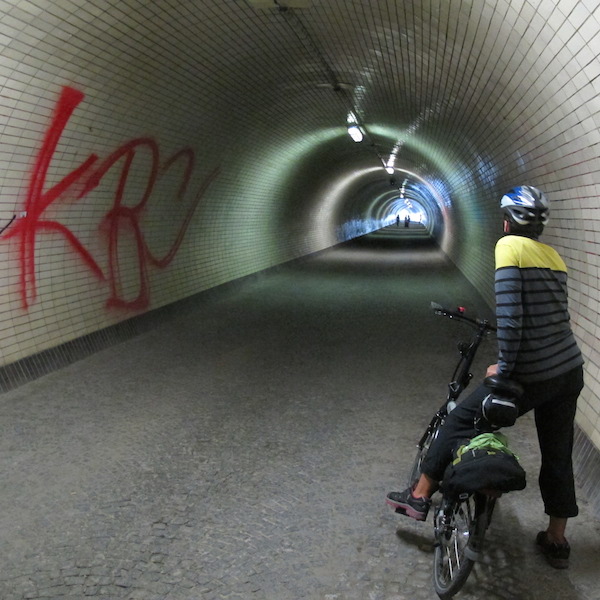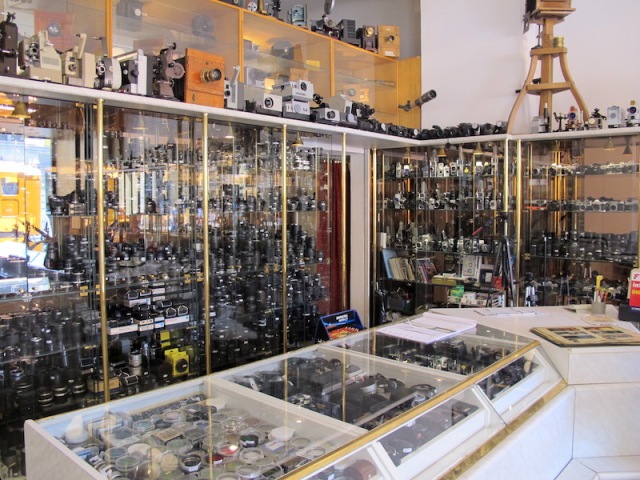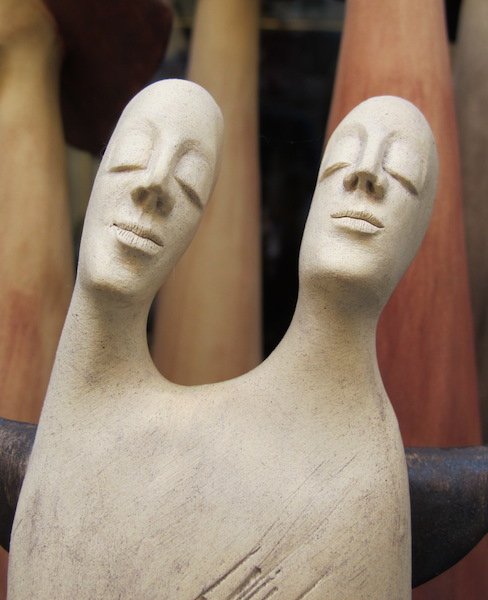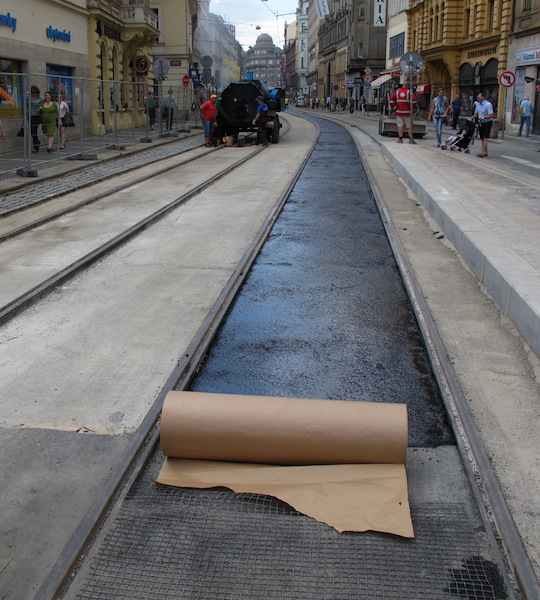PRAGUE PART 2: OFF THE BEATEN TRACK
There is a penalty to pay if you visit cities such as Prague at this time of the year: the penalty is the throngs of tourists. To avoid the masses we rode into the city early each day when it was relatively quiet and after visiting the popular sites early we took to the back streets in the afternoon.
This post deals with the things we found in the backstreets that the average tourist doesn’t see or cares to visit.
The advantage of using foldup bikes to explore a city is you can cover a lot of distance compared to walking. Also, pedalling doesn’t make one footsore. Our first out-of-the-city foray was to ride through some of the Prague tunnels and along a famous bike path said to be the most expensive bike path per single kilometre in the world; expensive, because it was an abandoned railway line which meant not only did a pavement have to be laid but bridges and tunnels needed restoration.
Bev loves tunnels because it’s easier to ride through a mountain than over it. Riding through dark tunnels like the one above is a very good reason to have lights on your bike.
The question here is, who was the trader? After some discussion Bev suggested that the trader could have been a drug dealer.

The Vitkov cycle path (disused railway line).
To date, we have not been harassed by any dogs other than the odd bark from lesser friendly dogs.
Partway along the bike path was a café called the Bajkazyl and all I can say is, it’s unique. The advertising blurb said, ‘Café-bar & bike culture factor. Moody living room and easy lounging/bike building workshop, store showroom & rentals. With a sunny balcony terrace area or couches. Locally master roasted coffee, ‘deli’ food plates, sandwiches and cakes. Combination w/ the bike life style & the possibility to try/rent a few choice custom recycled bikes. Sitting there watching the wheels going round and round. Directly on the Vitkov cycle track.
The bike shop not only had new and recycled bikes for sale but if riders on the nearby bike path had a breakdown they could pop in and scrounge through bike bits and pieces and thus keep their bikes on the road. At one end of the bike shop were bikes for sale and at the other end, a bar.

A very creative lampshade configuration. I think the drive sprocket attached to the bag was to stop it from flipping up when the fan was going.
Bajkazyl had a special way of doing things. Bev had a coffee and I asked for an iced tea and I thought it would be a Liptons in a plastic bottle but it was handmade, freshly-squeezed lime and lemon with ice and honey and not just one glass a whole jug full. Not only was the tea refreshing but so was the fact that I wasn’t responsible for the use of another plastic bottle.
***************************************************************
Another great find away from the tourist area was the Bun Cha Vietnamese restaurant, great food and a big plate costs from $4-50 to $6-00. It is no doubt one of the ‘Best Kept Secrets’ in Prague and to help any readers heading to Prague to find it I have drawn a map. The map shows other eating places we found that suited us fine as well.
(1) Gate Café, great breakfast with early morning sun. (2) Bun Cha Vietnamese Restaurant. We ate there at least five times. (3) Mujsalek Kavy (café) had a Parisian feel about and it was non-smoking, even outside, a rare find. (4) David’s Guesthouse, good budget accommodation. (5) The amazing Bajkazyl café on the bike track.
******************************************************
Another find close to my heart was a photographic shop.
Whilst we were in the shop a young girl came in and negotiated the purchase of a forty-year old Pentax 35mm film camera. This girl was probably one of a band of young people these days who want to do something different rather than use a digital camera. Shooting in black and white is very exciting and young people who have not known any other method than digital see it as something cool to do.
A particularly fascinating aspect of black and white photography is developing the film and then processing the prints. My first darkroom was portion of a closed in veranda and it was in there I processed hundreds of prints. Most were only family photographs and seeing the image appear in the developing tray always fascinated me.

Mexican taking a bull fiddle for a walk. One of my B & W photographs processed over forty years ago.
Medium format (negative size 6cm x 6cm) cameras like this Yashica and the Rollie were the cameras all amateur photographers like myself drooled over. There is a very entertaining book titled ‘Diary of an Amateur Photographer’ by Graham Rawle. The story is based around a young lad who purchased a medium format camera secondhand and to his dismay he found a roll of film in it with one frame exposed. Upon processing the film he found the image was that of a naked lady: the young photographer set out on a journey to discover who the naked lady was and to his surprise it turned out to be someone very close to him. And there lies the mystery. Obtainable secondhand via www.abebooks.com as well as many other used book outlets.
Both my sons have been, and still are, involved with photography. One actually was a professional photographer for some years. As small children they had a camera in their hands and at an early age I had them processing B & W film in the darkroom. Over the years we have experienced the full gamut of camera experiences ranging from 120 roll film using medium and large format cameras, similar to the Yashica in the previous photograph, through to digital ones. I’m sure I could start a camera museum without any trouble because I have my father’s old cameras as well.
************************************************************************
Our finds in a couple of the out-of-the way gift shops and galleries.
Being a ceramic artist for the past thirty-five years I appreciate the work of other ceramicists. The creative sculptures in the following five photographs are an example of long hours of work and devotion.
The reason cats and dogs fare frequently in art work in Prague is the Czech people have had a long tradition of keeping pets, particularly dogs and cats, and it goes back to Austro-Hungarian times. According to a poll by Focus (market and social research agency) 78% of Czech people had a dog as a pet and 40% a cat. This love of cats and dogs is no doubt the reason why there are very few feral cats and dogs on the streets.
Images of cats and dogs are everywhere….on mugs, tea towels, T-shirts and posters, postcards.
The dogs of Prague are very obedient. They stand with their owners without a whimper or a bark at traffic lights and when the walk light turns green they cross without any prompting from their owner. Their obedience probably comes from the city’s tolerance and attitude to them. A curious point is that on public transport if a dog doesn’t fit in a handbag it requires a ticket and a muzzle. Some people disguise the dog as a baby to avoid the fee.
The following print was a popular one.
Franz Kafka (1883-1924) was a German-language writer of novels and short stories. The above lino cut type image was on a Prague T-shirt and it has inspired me to learn more about Franz Kafka. I will attempt to find an English translation of one of his books.
**********************************************************
Every city in the world has its undesirable side and Prague is no exception.One of the most undesirable aspects is drunkenness and urination in public. Of course this doesn’t apply to all men nor all parts of Prague but it’s there and it is grossly indecent.
More beer is consumed per capita in the Czech Republic than any other country in the world, and what goes in has to come out and it comes out in public places, sometimes in full view of the public.
For us the problem is not the odour nor the fact that drunks urinate in the streets, it’s the broken bottles and broken glass means punctured tyres!
***********************************************************
And while I’m down at street level it’s worth looking at how many of the buildings in Prague are built. First glance at a well maintained building one would think they are made from solid stone and stuccoed over but this is not the case. The walls are often made of rubble and the outer stucco covering make the building look stylish.
There are a number of reasons why the stucco falls off and walls erode like this and they include: rising damp, wind erosion and of course the beer drinkers saturating the wall.

A wall made from rubble and a low-grade earth cement mix. Stucco covers the sins of the builder here.
*************************************************
Another down-at-ground-level activity I was fascinated with was the complicated system of laying tram tracks. Trams in European cities have been around for a long time and I expect they will be around for a lot longer too. There used to be trams in Sydney and the depot for the Sydney trams is where the Opera House now stands. Sydney trams had open sides and people used to hop on and off with ease. But by 1961 the tram services had been discontinued and buses were introduced, a backward step say many Sydneysiders.
A term commonly used when I was young and living in Sydney was ‘he shot through like a Bondi tram’ meaning he went in a hurry. Bondi is of course the famous beach in the southern suburbs.
Some might wonder why anyone cares about how tram tracks are laid but I care because it takes a lot of skill and physical effort to do a job as neat as this and the workers deserve some credit so I’m giving them some.

Filling in the gaps between the settes. Settes are the squared stones. It would not do to have one pop out and land on the line.
In general, people call stone pavements like the one above cobbles but technically this is incorrect. Cobbles are water-worn round stones. Settes are roughly squared or rectangular in shape.

Cobblestone wall and pavement in Le-Puy, France. Cobblestones are water-worn beach or river stones and their shape enabled horse hooves to grip.
As I mentioned previously, setts or cobbles can make life uncomfortable for the cyclist, however streets paved with them are highlights in several cycling competitions such as the final Champs-Elysees stage of the Tour de France. The difficult riding over such surfaces adds a dangerous element to the race.
The use of different colours is reserved for areas of importance. Prague is particularly well known for its variation of settes and cobbles. Paved roads of cobble and sette are noisy, which is an advantage for cyclists as approaching traffic can be easily heard. In earlier times straw was scattered on the cobbles if noise of traffic needed to be dampened. This was often done outside a sick or dying person’s house.
Looking at sette or cobble stone footpaths or roads sets me to thinking about how much work collectively man has carried out over the ages, for example the laying of cobbles and settes, tramlines, railway lines, the building of bridges, thousands of kilometres of stone fences, high-rise buildings and ancient monuments such as the Parthenon. And what about the huge excavations such as open cut mines? All the digging, scratching and building overwhelms me. Will it stop when every square kilometre of the planet has been dug up or covered?

Bev about to share a tunnel with a tram. Building a decorative tunnel like this took a lot of skill and hard work.
***********************************************
Most of the tourists do not come to wonder about cobblestone roads or tramway construction. They come for entertainment. Tour operators know this and they tap into the tourists needs very effectively.

A few of the many Prague tourist brochures, some inviting tourists to explore the dark eras of Prague, fire a Kalashnikov high-powered weapon or command a military tank.
In the above selection there are two brochures encouraging tourists to explore two dark eras of Prague, WW2 under Nazi occupation and the post WW2 communist domination.
In Encountering the Past Part 1 I wrote about the rise and fall of the Third Reich (Archives 2012 Munich Part 2) and I showed images of the Munich Nazi Headquarters where Adolf Hitler, Italy’s Mussolini, French Premier Eduard Daladier and British Prime Minister Neville Chamberlain signed the Munich Agreement. The agreement was signed as quoted by Chamberlain ‘to secure peace in our time’. The settlement permitted Nazi Germany’s annexation of portions of Czechoslovakia along the country’s borders.

From left to right : Chamberlain, Daladier, Hitler and Mussolini before signing the agreement which gave Sudutenland to Germany. (photo credit: German Federal Archives/Wikipedia).
Peace of course was not secured: the signing of the pact meant the fate of Czechoslovakia was sealed for many years to come. Under Nazi rule Czech people, including those living in Prague, were treated brutally and mass executions and banishment to forced labour camps were common.
After Germany’s capitulation Czechoslovakia came under Soviet domination and remained at the mercy of the Soviets until 1989. One tyrannical regime was replaced by another and citizens who did not comply with the ideals of socialism were interrogated, intimidated and put under surveillance. People were imprisoned for speaking out against the communist system. Members of the intelligentsia were forced to do menial jobs or shipped off to labour camps.
People accused of crimes against the state were put on trial. The trials were not in the least fair as judges cooperated with the country’s leadership. The defendants were branded guilty before their trial began. Many of the accused even had to rehearse their testimonials in advance as if it was a cruel play instead of a courtroom. Almost 180 people were executed.
The tour operators in Prague have tapped into these dark and dismal days and guided tours covering every aspect of Prague’s history is on offer. For me the misery of the dark times is lost when mass tourism rules. I have yet to make my mind up about the benefits of mass tourism in places where cruelty and mass deprivations were the norm.
************************************************
And now to a snapshot of Prague, images that we want to share.
There was no apparent support other than the broom handle-sized stick. Some people actually ran their hand horizontally between the hat of the person sitting on the ground and the feet of the one being supported.
The only thing I saw in Prague that I wanted to take home was……….

……a plastic-wheeled wheelbarrow. If I had one of these I would never have to fix a flat tyre on a wheelbarrow again.
I found this post card in Prague and gave it to my bike-riding friend Rolf in Zurich. Einstein thought of this when riding his bicycle. In addition to ‘Life is like riding a bicycle’ he added, ‘If you don’t keep your balance you fall over’.
That’s the end of our Prague postings. Our next posting will be the start of a bike adventure through the Czech Republic, Germany and Poland. We hope you stay with us. Don’t forget leave a comment in the comments box and if you want to be advised when we do a posting click on FOLLOW on the bottom righthand corner of your screen.


















































To our favourite travellers,Fred,Bev &Thomas.Well, we have finally caught up on all your blogs. I like to sit down with plenty of time to read up and absorb all your amazing stories,info and photos and last weekend gave me that time as it was cold, wet and windy, ideal conditions for following you
on your incredible journey.Thank you for all your lovely postcards also.I can”t get enough of your
stories and photos and read your blogs over and over.Love the fold up bikes and your photo of
the plastic wheeled wheelbarrow, that would have had the perfect home at “Braecroft”.I have now
started reading your blogs from June 2012 which are just as fascinating!!.Glad you are both keeping
well apart from the food poisoning episode, I have also encountered that while overseas and it is
not pleasant.We are all well here and have just returned from a week in Queenstown NZ for a family wedding which was beautiful and we also fitted in a few days skiing and snowboarding.
Have a wonderful time travelling with Thomas through France, looking forward to the next blog.
Travel Safe.
Love Kevin,Sue and Family